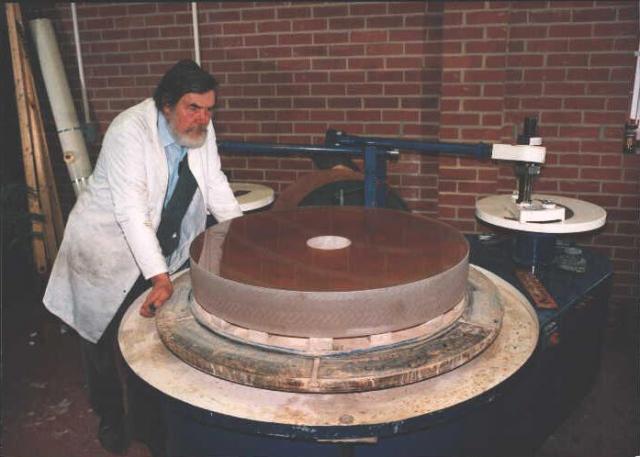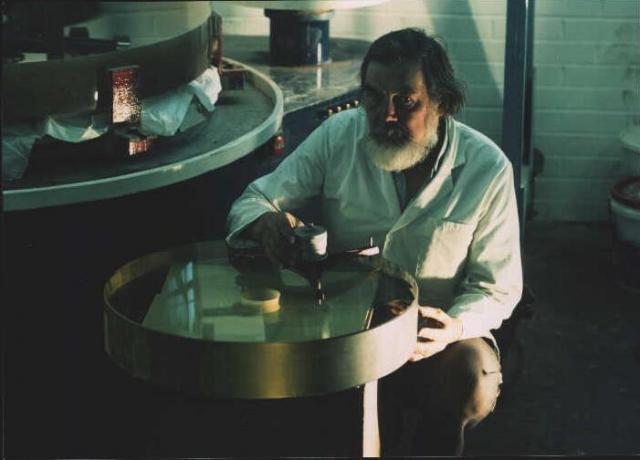› Forums › General Discussion › David Sinden Remembered
- This topic has 14 replies, 4 voices, and was last updated 10 years, 4 months ago by
 Andy Wilson.
Andy Wilson.
-
AuthorPosts
-
4 August 2015 at 10:18 am #573460
John Nichol
Participant29th August 2005 saw the passing of David Sinden who was the last chief optician at the word renowned telescope making firm of Sir Howard Grubb Parsons: better know simply as Grubb Parsons. This year is the 10th anniversary of David’s passing away and in commemoration I would like to make a few posts this month highlighting some of his achievements. After leaving Grubb Parsons David went on to set up the Sinden Optical Company which ceased trading after his death in 2005. He was a long standing member of the BAA.
The Anglo Australia Telescope (AAT) was the largest telescope that David worked on; he was responsible for overseeing the manufacture of the 3.9 m diameter mirror. The telescope was inaugurated in 1974 and began making observations in 1975. The telescope has the distinction of being one of the last 4m class equatorially mounted telescopes ever made. Subsequent large telescopes adopted computer controlled alt-azimuth mounts. The telescope has a superb reputation both for the quality of its optics and its productivity. In 2000 the UK withdrew its involvement in the telescope (surprise), which is now called the Australian Astronomical Telescope (AAT).
More to follow…….
John
4 August 2015 at 5:15 pm #576944John Nichol
ParticipantHere is a picture of Dave with the original 98 inch mirror for the Isaac Newton Telescope….
5 August 2015 at 11:25 pm #576946David Pettitt
ParticipantHi John, I dont see the picture but I remeber a BAA meeting in Newcastle when we visited Grubb Parsons and saw the Isaac Newton telescope after it had been refurbished ready for its move to La Palma. The mount had to be modified for the different latitude, etc.
7 August 2015 at 10:06 am #576947John Nichol
ParticipantSorry about the picture David, not too sure what is going on there!
At last autumn’s Kielder star party an excellent talk was given by Professor Andy Newsam highlighting the work of the highly successful Liverpool telescope. The secondary mirror for the telescope was made by the Sinden Optical Company, it is about 60cm in diameter and is convex in shape which makes it very difficult to test as such a mirror does not form a real image. In addition the surface has a shape described as hyperbolic. Such optical components are renowned for being difficult to make. Had David been sitting in the audience that day he would have had good reason to be satisfied with his contribution to the Liverpool Telescope and its part in the advancement of astronomy.
For more information about the Liverpool telescope look here.. http://telescope.livjm.ac.uk/
John
8 August 2015 at 5:55 pm #576949John Nichol
Participant 11 August 2015 at 11:47 am #576958
11 August 2015 at 11:47 am #576958John Nichol
ParticipantThe Espin Telescope
Thomas Henry Espinall Compton Espin was vicar of Tow Law, Co. Durham, from 1888 until his death in 1934, aged 76. He was a keen astronomer with an interest in double stars; he went on to personally discover and map an amazing 2,575 of these and was helped in his work by William Milburn, his assistant observer. Espin’s main telescope was a 24 inch reflector by the famous maker George Calver. After Espin’s death the telescope fell into disuse, it is said that chickens took up residence in the tube! The telescope was eventually rescued and fully restored by David who then presented it to the Newcastle University observatory at Close House. In August 2004, one year before David’s untimely death, Newcastle University sold Close House mansion and golf course which were redeveloped as a hotel. As a result of this the observatory fell into disuse and the 24 inch telescope suffered once again from neglect. The latest news I have is that the telescope has been removed from the leaking dome and is now in storage. Perhaps a fitting tribute to this historical telescope would be relocation to Beamish museum where it could be enjoyed by the many visitors.
John
18 August 2015 at 11:27 am #576977John Nichol
ParticipantThe Sinden Optical Company (SOC) had considerable success in the production of camera obscuras. The following is taken from the original SOC website and was almost certainly written by Dave…
The instrument produces an image on a curved horizontal screen placed in the centre of a darkened room. Observers stand around the screen, looking down at a convenient angle. The viewing screen is curved for the same reason that the retina of the human eye is curved. The image is luminous and in full colour, with movements the outside screen reproduced exactly as nature. In good light conditions the image is filled with luminous delicate colour. Subtle, seductive and very beautiful in its nature. This is “real” light and living colour painted directly onto the screen by nature itself. Sunsets with the Camera Obscura can be quite breathtaking beyond words!
SOC went on to produce a number of camera obscuras including:
The national Garden festival in Gateshead.
The TaviraTower, Cadiz.
The Castelo de S. Jorge, Lisbon, Portugal
JerezSpain
Habana, Cuba
ForedownTower, Hove, E Sussex
The SOC website goes on to say..
Our large Camera Obscura is designed and engineered to last for a very many years with the minimum possible maintenance. The main lens of our instrument is an astronomical aplanatic which is normally made about 12” in diameter and with a focal ratio designed to suit the proposed building. The instrument can be rotated in Azimuth and Altitude so as to cover the whole horizon. The concave screen is usually about 2 metres diameter and can be raised or lowered to control the focus over a large range. We supply and install the complete instrument including the viewing screen. We can advise you on building modifications and arrangements necessary to accommodate the Camera Obscura.
19 August 2015 at 7:39 pm #576978John Nichol
Participant 20 August 2015 at 9:57 am #576979
20 August 2015 at 9:57 am #576979 Martin MobberleyParticipant
Martin MobberleyParticipantDavid gave a very interesting talk in May 1999 to the Association.
There’s a copy online on the NASA ADS server starting here:
http://articles.adsabs.harvard.edu/full/seri/JBAA./0109//0000339.000.html
Martin
26 August 2015 at 9:14 am #576990John Nichol
ParticipantThere are many anecdotes surrounding David, here is on of my favourites….
David had been for a night out with his wife Helen; they were using their usual form of transport, a motorcycle. On the journey home David decided that he would do some observing, there was a meteor shower that evening and one of David’s interests was trying to photograph the spectrum of a meteor using a prism in front of the camera lens. On arriving home Helen went into the house and David went into the garden to set up is equipment which he stored in the garden shed. After few minutes Dave heard a voice from over the garden wall,” Good evening sir”, he turned to see a policeman. Dave realised some explaining would be needed. After describing that meteors were really particles of rock passing through the Earths atmosphere the policeman looked at Dave and said, “That would explain the crash helmet you are wearing then sir!”.
John
26 August 2015 at 7:29 pm #576991John Nichol
ParticipantIn recognition of David’s work an asteroid was named in his honour: 10369 SINDEN
What better lasting memorial could anyone hope for?
John
27 August 2015 at 10:11 am #576993John Nichol
ParticipantDavid undertook a lot of restoration work on the historical telescopes at Armagh Observatory…
http://star.arm.ac.uk/history/Domes/Sinden/
http://star.arm.ac.uk/movies/Grubb15inch/
http://star.arm.ac.uk/history/Domes/15inch/Jan/
http://star.arm.ac.uk/history/instruments/Calver/Calver.html
John
28 August 2015 at 10:30 am #576994John Nichol
ParticipantHere is a list of some of the instruments David worked on at Grubbs……
48-inch reflector, Victoria, Canada, 1961
40-inch reflector, Pic du Midi, France. Optics only 1962
The 40 inch Elizabeth telescope. S. Africa 1963
74-inch reflector, Helwan (Kottamia), Egypt, 1963
30-inch reflector, Jungfraujoch, Switzerland, 1966
16/24-inch Schmidt, Castel gandolfo, 1967
The 98 inch Issac Newton Telescope at Grubb Parsons. 1967
72 inch (182cm) Mirror for Padua, Italy. 1973
48/72-inch Schmidt, Siding Spring, Australia, 1973
154 inch Reflector, Siding Spring, Australia. 1974
48-inch reflector, Athens University, Greece, 1975
150-in mirror, UKIRT, Hawaii, 1976
60 inch Reflector, La Silla, Chile 1976
29 August 2015 at 9:22 am #577003John Nichol
ParticipantIf you have read through my previous posts you will have some idea about the man and his achievements. Dave was a character and left a lasting impression with those who had the good fortune to meet him. As well as working at was the cutting edge of astronomical optics he also devoted time to popularising astronomy. He was a great talker, it has been said that he could have talked for England. He always had time for people giving freely of his knowledge and experience.
By the time I met David I had already made my first telescope mirror; his enthusiasm inspired me onwards and upwards. Optics became an important part of my life and still is today.
If you would like to read more about David, or indeed his beloved Grubb Parsons, please have a look at my webpage:
https://sites.google.com/site/grubbparsons/home/grubb-parsons
It is a great shame that the national astronomy magazines have missed the opportunity to celebrate David’s life and achievements.
David Sinden 1932-2005 RIP
30 August 2015 at 3:57 pm #577006 Andy WilsonKeymaster
Andy WilsonKeymasterHi John,
Interesting to read your posts on David’s career. That is an impressive list of telescopes which he worked on, they must have contributed a wealth of data and discoveries.
Best wishes,
Andy
-
AuthorPosts
- You must be logged in to reply to this topic.
